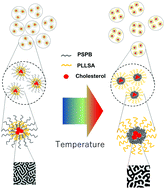Development and structural analysis of dual-thermo-responsive self-assembled zwitterionic micelles†
Abstract
Multi-stimuli-responsive materials may dominate next-generation drug delivery systems. Herein, dual-thermo-responsive micelles were prepared by introducing cholesterol chloroformate to facilitate the spontaneous self-assembly of graft polymers prepared by combining two charged polymers, poly-sulfobetaine and carboxylated ε-poly-L-lysine. This polymerization was controlled by reversible addition fragmentation chain transfer polymerization. Turbidimetry measurements and temperature-dependent 1H NMR spectroscopy were used to investigate the phase transition behaviors; transmission electron microscopy and atomic force microscopy were used to determine the morphology of the micelles. The dependence of self-assembled structures on temperature was investigated through ultra-small-angle X-ray scattering (USAXS). The micelles formed spherical shapes in water which was confirmed by TEM and AFM. Interestingly, different, temperature-dependent micelle size change behaviors were observed through dynamic light scattering, Ultraviolet-visible (UV-Vis) spectroscopy, and USAXS; this might be due to the concentration-dependent hierarchical phase transition. This study provides crucial information on the mesoscopic structure of the micelles, and will enable greater control over their transition temperatures for numerous biomaterial applications.



 Please wait while we load your content...
Please wait while we load your content...